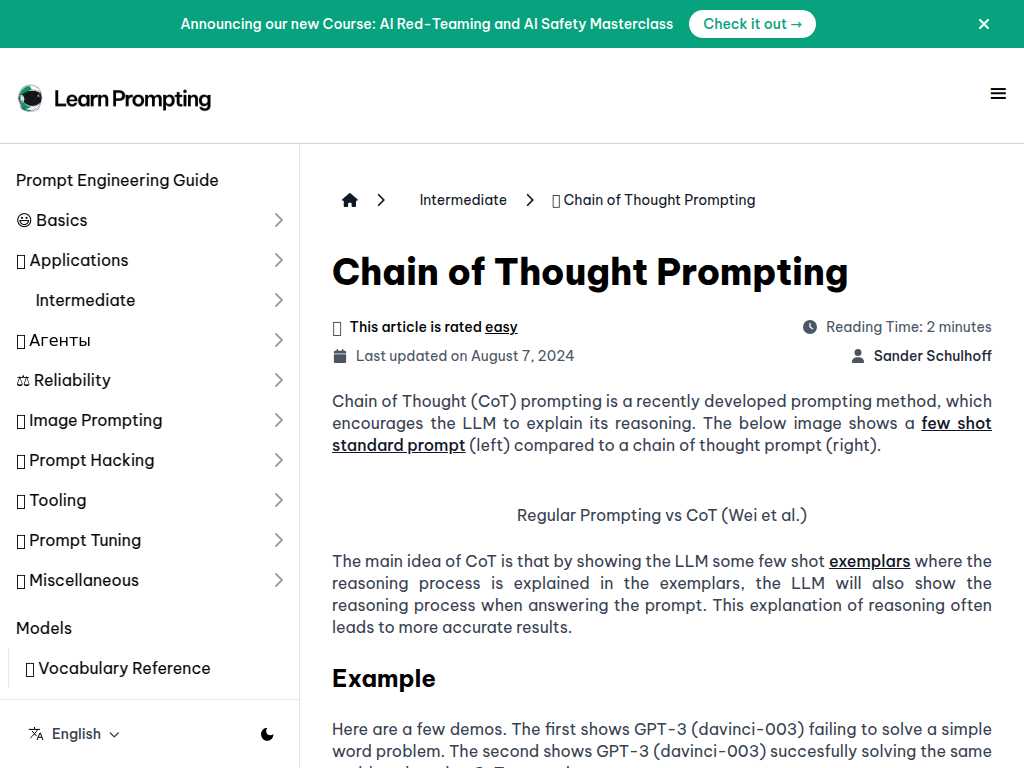Chain of Thought Prompting
Natural Language Processing

Boost LLM reasoning with Chain-of-Thought Prompting.
Average rated: 0.00/5 with 0 ratings
Favorited 0 times
Rate this tool
About Chain of Thought Prompting
Chain-of-Thought (CoT) prompting is a sophisticated technique aimed at enhancing the reasoning abilities of Large Language Models (LLMs). This innovative approach is designed to advance the accuracy of LLM responses for complex tasks that involve multi-step reasoning. By encouraging models to explicitly articulate their reasoning process in a step-by-step manner, CoT prompting significantly differs from standard prompting methods, which seek direct answers without elucidating the steps involved. The technique operates by supplying the LLM with examples where the reasoning process is clearly outlined, thus prompting the model to replicate this approach in subsequent prompts. Key features of CoT prompting include step-by-step reasoning, which allows the LLM to dissect complex problems into smaller parts, leading to more accurate and interpretable solutions. This detailed reasoning process enhances accuracy by enabling the model to identify and correct errors along the way. Additionally, CoT provides transparency, offering insights into the model's decision-making, thereby facilitating a deeper understanding and evaluation of its outputs. CoT prompting is particularly beneficial in domains requiring intricate reasoning, such as mathematical problem-solving, logical reasoning tasks, commonsense reasoning challenges, symbolic reasoning, and complex question answering. By contrast to other techniques, CoT stands out with its improved accuracy on complex tasks, increased transparency, and better generalization capabilities, making it a powerful tool for complex reasoning problems. The effectiveness of CoT prompting, however, is heavily dependent on the size of the LLM, with larger models—those exceeding 100 billion parameters—generally exhibiting superior performance. Smaller models may sometimes yield illogical reasoning chains, thus diminishing the accuracy of outcomes compared to standard prompting techniques. CoT prompting can be integrated into various systems utilizing LLMs as part of larger prompt engineering strategies, often in combination with methods like few-shot learning or self-consistency. Its introduction by Google AI researchers in 2022 marked a significant leap in prompt engineering, garnering acknowledgment for its contribution to substantial improvements in LLM performance across diverse benchmark datasets. Recent research endeavors are investigating continuous innovations like Zero-shot CoT, which applies the method without explicit examples, leveraging the model's innate reasoning capacity. Other developments include Automatic CoT (Auto-CoT) for automating reasoning chains, Faithful CoT to ensure authentic representation of reasoning steps, and Contrastive CoT that seeks to enhance reasoning by examining alternative thought paths. Overall, CoT prompting represents a notable advancement in the field of prompt engineering, offering considerable benefits for complex reasoning tasks and promising continued improvements through ongoing research and development.
Key Features
- Enhances reasoning by prompting step-by-step explanation.
- Improves interpretability and transparency of model responses.
- Increases accuracy and reliability, especially for complex tasks.
- Supports improved handling of arithmetic and commonsense tasks.
- Benefits larger language models more significantly.
- Offers both few-shot and zero-shot variations for implementation.
- Incorporates Auto-CoT for generating reasoning chains efficiently.
- Uses Contrastive CoT with positive and negative examples to refine reasoning.
- Aims for faithful representation of the model’s reasoning with Faithful CoT.